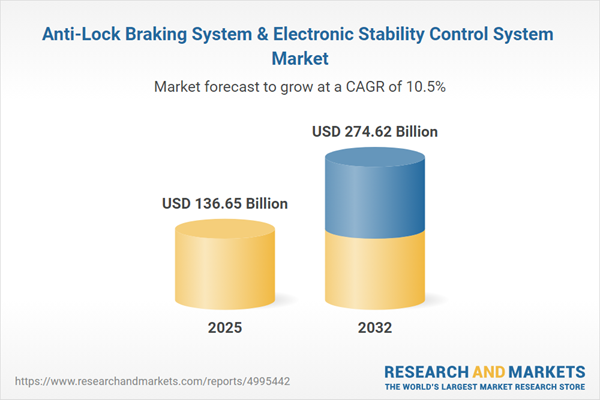Speak directly to the analyst to clarify any post sales queries you may have.
Senior automotive decision-makers are responding to a complex ABS and ESC landscape. Industry priorities are shifting as global safety regulations evolve, technology platforms become smarter, and operational requirements diversify by region. To maintain compliance and drive innovation, executives require focused, actionable market intelligence.
Market Snapshot: ABS and ESC Market Trends
The anti-lock braking system (ABS) and electronic stability control (ESC) market is demonstrating steady expansion, driven by a worldwide push for optimized vehicle safety. Automotive manufacturers and supply partners are intensifying efforts to integrate advanced safety mechanisms, with regulatory frameworks serving as both catalyst and benchmark for market agility. The sector is witnessing a technological shift, as companies introduce modular and integrated system designs able to adapt to local compliance needs and support multiple vehicle formats. This evolution is also enhancing brand differentiation, enabling firms to meet a wider array of customer and regulatory demands while covering diverse mobility solution offerings.
ABS and ESC Market: Scope & Segmentation
- Sales Channels: Analyzes both direct OEM installations and aftermarket upgrade pathways, vital for synchronizing regulatory compliance and supporting the ongoing upgrade of in-service vehicles.
- Vehicle Types: Considers implementation across passenger vehicles and commercial fleets, underlining the variation in strategic needs, consumer priorities, and regulatory frameworks affecting deployment plans.
- System Types: Evaluates conventional ABS and ESC units alongside integrated models enhanced with traction control or rollover mitigation, highlighting strategic choices for mainstream and premium market segments.
- Propulsion Methods: Reviews fitment in vehicles with internal combustion engines as well as hybrid, electric, and alternative powertrains, providing insight into how ABS and ESC technology aligns with drivetrain transitions and sustainability targets.
- Channel Architecture: Explores the use of two-, four-, and eight-channel configurations, delivering insights into the scalability of safety systems and their fit for various operational profiles and market tiers.
- Regional Coverage: Details compliance expectations and business opportunities across the Americas, Europe, Middle East, Africa, and Asia-Pacific, allowing companies to tailor solutions for local and multinational product lines.
- Key Companies: Profiles leading market participants, including Robert Bosch GmbH, Continental AG, ZF Friedrichshafen AG, Aisin Seiki Co., Ltd., Hyundai Mobis Co., Ltd., Hitachi Astemo, Ltd., Mando Corporation, Nissin Kogyo Co., Ltd., Aptiv PLC, and Knorr-Bremse AG, examining their adaptation strategies in the context of technology shifts and evolving partnership models.
Key Takeaways for ABS and ESC Strategy
- Meeting evolving safety requirements necessitates a balance between rapid technology rollouts and maintaining process flexibility, with successful integration across multiple product lines and international regions.
- The movement toward electrified and autonomous vehicles is expanding the importance of advanced electronic safety systems as operational differentiators and enablers of reliable fleet performance.
- Strengthening partnerships between manufacturers and suppliers is facilitating quicker adaptation to regulatory updates and supporting agile deployment of modular safety technologies across diverse markets.
- Designing platforms with flexible architectures increases preparedness for both country-specific and global compliance requirements, promoting operational resilience and supporting nuanced market strategies.
- The adoption of data-driven safety platforms is improving the management of braking system lifecycles and enabling clearer, data-supported decision-making at the executive level.
Tariff Impact and Supply Chain Dynamics
New tariffs levied on imported electronic braking systems have reshaped the way automotive OEMs approach their supply chains for ABS and ESC components. Companies are prioritizing nearshoring and bolstering supplier relationships to reduce risks connected to cross-border trade instability. Modular system architecture is being leveraged to maintain manufacturing consistency even during supply disruptions. Standardized sourcing and engineering practices are strengthening the protection of supply lines and controlling procurement expenses amid changing trade policies and fluctuating international prices.
Methodology & Data Sources
This report utilizes a multi-source approach, integrating perspectives from senior executive interviews, targeted technical literature, and comprehensive market and production data reviews. The research includes input from original equipment manufacturers, prominent suppliers, and regulatory entities, ensuring industry-specific insight and up-to-date market intelligence for the ABS and ESC environment.
Why This Report Matters for Senior Leaders
- Enables effective navigation of ABS and ESC market complexities, ensuring strategic procurement and market entry decisions suited to diverse regulatory landscapes.
- Clarifies regional and global risks and opportunities, providing a foundation for robust business strategies and comprehensive operational planning.
- Highlights the significance of technology-driven safety advancements and proactive supply management for maintaining adaptability and competitiveness in a changing sector.
Conclusion
The research offers senior automotive leaders timely, substantiated insights for proactive ABS and ESC strategy development. It provides a solid foundation for informed decisions amid evolving technologies and regulatory requirements.
Additional Product Information:
- Purchase of this report includes 1 year online access with quarterly updates.
- This report can be updated on request. Please contact our Customer Experience team using the Ask a Question widget on our website.
Table of Contents
3. Executive Summary
4. Market Overview
7. Cumulative Impact of Artificial Intelligence 2025
Companies Mentioned
The companies profiled in this Anti-Lock Braking System & Electronic Stability Control System market report include:- Robert Bosch GmbH
- Continental AG
- ZF Friedrichshafen AG
- Aisin Seiki Co., Ltd.
- Hyundai Mobis Co., Ltd.
- Hitachi Astemo, Ltd.
- Mando Corporation
- Nissin Kogyo Co., Ltd.
- Aptiv PLC
- Knorr-Bremse AG
Table Information
| Report Attribute | Details |
|---|---|
| No. of Pages | 199 |
| Published | October 2025 |
| Forecast Period | 2025 - 2032 |
| Estimated Market Value ( USD | $ 136.65 Billion |
| Forecasted Market Value ( USD | $ 274.62 Billion |
| Compound Annual Growth Rate | 10.5% |
| Regions Covered | Global |
| No. of Companies Mentioned | 10 |









